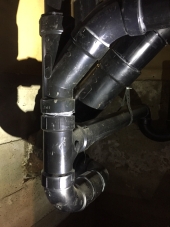I didn't read the entire thread before posting. I thought you were looking for a first flush diverter. Unfortunately the ball in tube idea won't work to stop pressurized water, even with low pressure.
However, I think what you are trying to do can be done without any valves.
Connect all of the lower tanks with some 1.5" to 2" PVC or ABS pipe, at one end of the pipe put an elbow and a vertical pipe that extends up to just below the top of the upper tanks. At the top of this pipe put a Tee.
Connect all of the upper tanks the same way and add a vertical riser that goes up next to the one from the lower tank and stops at the same point. Add an ellbow to this riser and connect it to the Tee ^.
Fill the upper tanks first, when they are nearly full the excess will flow up the pipe, through the elbow and down into the lower tanks.
Now all you have to do is handle overflow from the lower tanks, that is simple too. Cut the riser from the lower tanks just before the top of the lower tanks and add a "sanitary tee" (see below), this will allow the water comming down to flow into the lower tanks until they are full and then the overflow will go out the tee. Using a sanitary tee will keep water that is running down the side of the pipe from going out the tee until the tank is full.

There you go, automatic filling, overflow control, no moving parts and no maintenance required.





















 1
1




 1
1

























